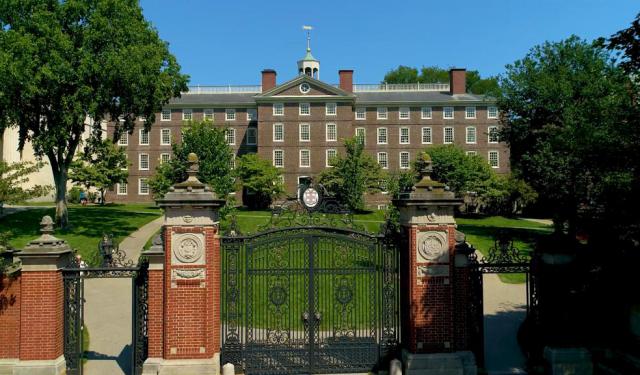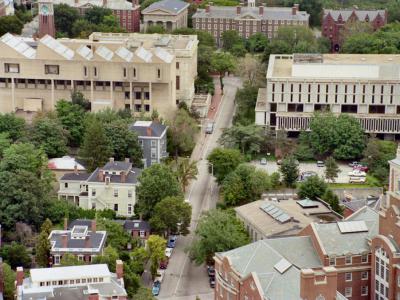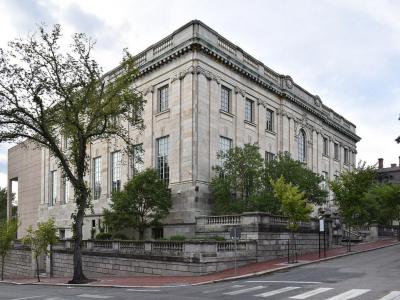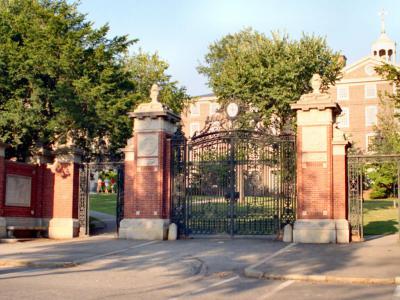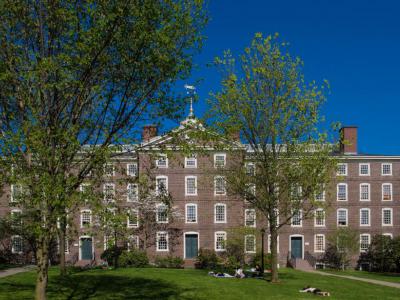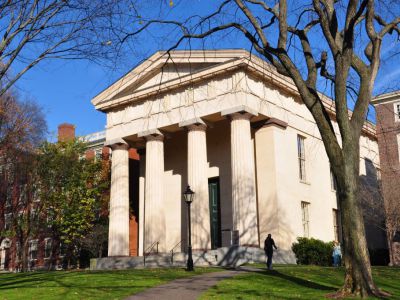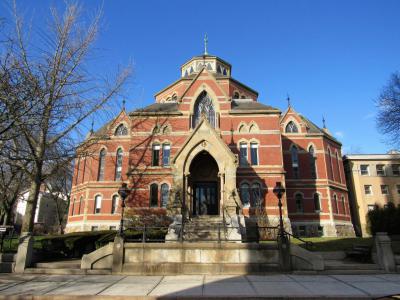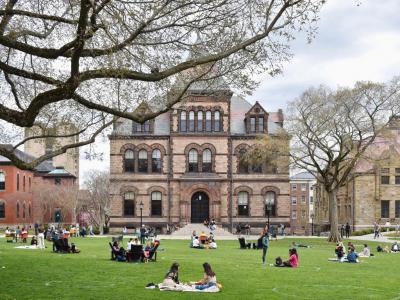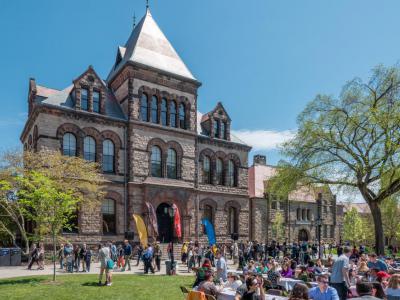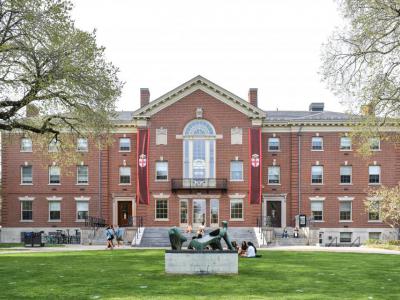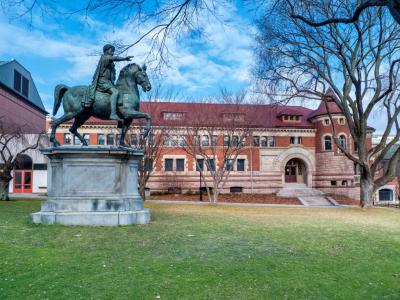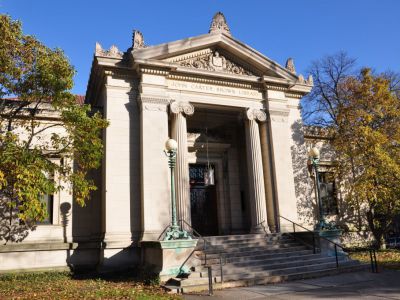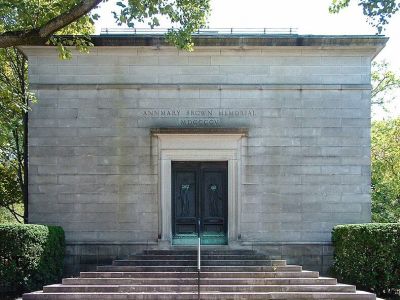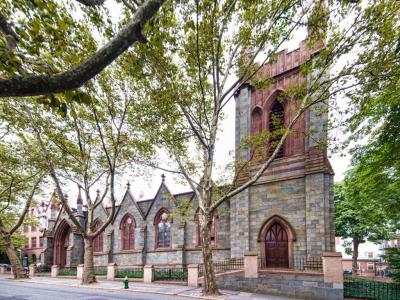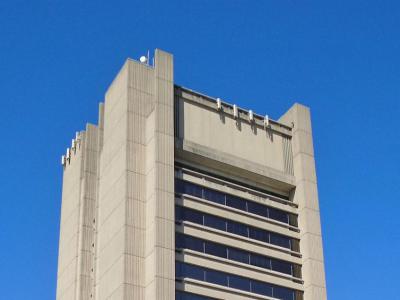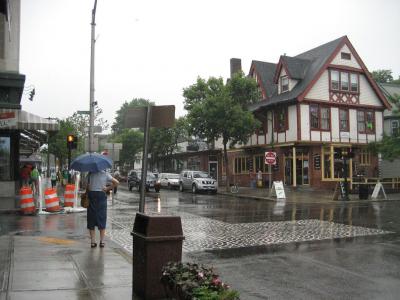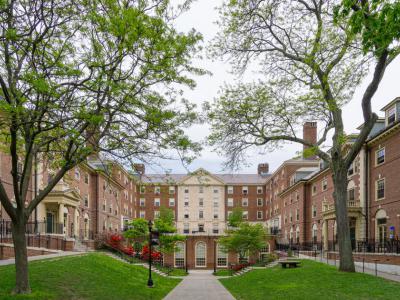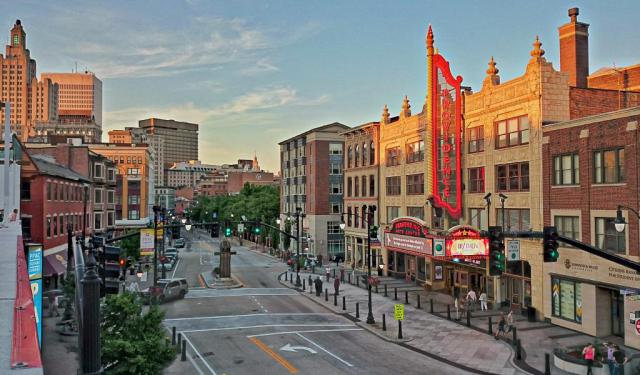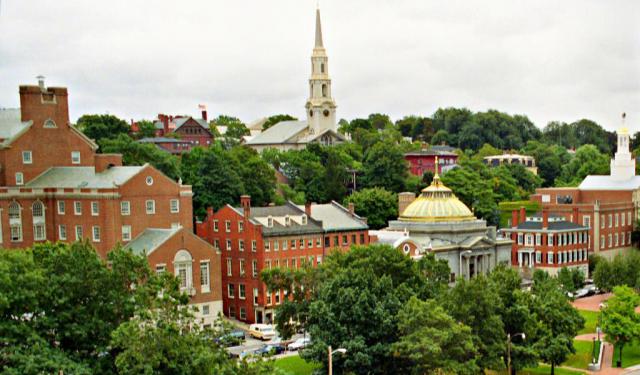Brown University Walking Tour (Self Guided), Providence
Chief among the iconic landmarks contributing to the cultural atmosphere of Providence, Rhode Island, is Brown University, a prestigious Ivy League institution known for its liberal arts education and vibrant campus life. Founded in 1764, this is the seventh-oldest university in the United States, chartered before the American Revolution.
Brown's historic campus offers a classic New England college experience and is fairly easy to find, heading down the historic, pedestrianized College Street. A brick and wrought-iron fence punctuated by decorative gates and arches traces the block's perimeter dominated by Georgian and Richardsonian Romanesque buildings, dating from 1770-1926.
One of the most notable structures here is the John Hay Library, housing extensive collections of rare books and manuscripts. Nearby, the Van Wickle Gates mark the ornamental entrance to the campus, leading visitors into the serene "Quiet Green" where students often gather to study or socialize. The majestic University Hall, the first building on campus, erected in 1770, is a symbol of Brown's academic excellence.
For those interested in anthropology, the Haffenreffer Museum of Anthropology Gallery offers fascinating exhibits, while Robinson Hall, another prominent site, hosts the university's Department of Economics.
The heart of campus life revolves around the Main Green, a picturesque open space surrounded by academic facilities. Sayles Memorial Hall and Faunce House are popular venues for events and student organizations. Lyman Hall, initially built as a gymnasium, today is the primary venue for the Department of Theatre Arts and Performance Studies.
The John Carter Brown Library and Annmary Brown Memorial are valuable resources for research and scholarship. Meanwhile, Saint Stephen's Episcopal Church is a listed building on the National Register of Historic Places and a tranquil place for spiritual reflection.
For students seeking academic resources, the Sciences Library on Thayer Street provides access to a wide range of materials and study spaces. Pembroke College, now integrated into Brown University, holds a special place in the institution's history and continues influencing its educational mission.
In essence, Brown University is a dynamic and intellectually stimulating environment for those keen to learn. Suppose you're ready to embark on an enriching academic journey and experience all that Brown has to offer. In that case, we encourage you to explore the university's campus now and perhaps discover its potential as your future alma mater!
Brown's historic campus offers a classic New England college experience and is fairly easy to find, heading down the historic, pedestrianized College Street. A brick and wrought-iron fence punctuated by decorative gates and arches traces the block's perimeter dominated by Georgian and Richardsonian Romanesque buildings, dating from 1770-1926.
One of the most notable structures here is the John Hay Library, housing extensive collections of rare books and manuscripts. Nearby, the Van Wickle Gates mark the ornamental entrance to the campus, leading visitors into the serene "Quiet Green" where students often gather to study or socialize. The majestic University Hall, the first building on campus, erected in 1770, is a symbol of Brown's academic excellence.
For those interested in anthropology, the Haffenreffer Museum of Anthropology Gallery offers fascinating exhibits, while Robinson Hall, another prominent site, hosts the university's Department of Economics.
The heart of campus life revolves around the Main Green, a picturesque open space surrounded by academic facilities. Sayles Memorial Hall and Faunce House are popular venues for events and student organizations. Lyman Hall, initially built as a gymnasium, today is the primary venue for the Department of Theatre Arts and Performance Studies.
The John Carter Brown Library and Annmary Brown Memorial are valuable resources for research and scholarship. Meanwhile, Saint Stephen's Episcopal Church is a listed building on the National Register of Historic Places and a tranquil place for spiritual reflection.
For students seeking academic resources, the Sciences Library on Thayer Street provides access to a wide range of materials and study spaces. Pembroke College, now integrated into Brown University, holds a special place in the institution's history and continues influencing its educational mission.
In essence, Brown University is a dynamic and intellectually stimulating environment for those keen to learn. Suppose you're ready to embark on an enriching academic journey and experience all that Brown has to offer. In that case, we encourage you to explore the university's campus now and perhaps discover its potential as your future alma mater!
How it works: Download the app "GPSmyCity: Walks in 1K+ Cities" from Apple App Store or Google Play Store to your mobile phone or tablet. The app turns your mobile device into a personal tour guide and its built-in GPS navigation functions guide you from one tour stop to next. The app works offline, so no data plan is needed when traveling abroad.
Brown University Walking Tour Map
Guide Name: Brown University Walking Tour
Guide Location: USA » Providence (See other walking tours in Providence)
Guide Type: Self-guided Walking Tour (Sightseeing)
# of Attractions: 16
Tour Duration: 2 Hour(s)
Travel Distance: 2.3 Km or 1.4 Miles
Author: alice
Sight(s) Featured in This Guide:
Guide Location: USA » Providence (See other walking tours in Providence)
Guide Type: Self-guided Walking Tour (Sightseeing)
# of Attractions: 16
Tour Duration: 2 Hour(s)
Travel Distance: 2.3 Km or 1.4 Miles
Author: alice
Sight(s) Featured in This Guide:
- College Street
- John Hay Library
- Van Wickle Gates and the Quiet Green
- University Hall
- Manning Hall
- Robinson Hall
- Main Green
- Sayles Hall
- Faunce House (Stephen Robert '62 Campus Center)
- Lyman Hall
- John Carter Brown Library
- Annmary Brown Memorial
- Saint Stephen's Episcopal Church
- Brown University Sciences Library
- Thayer Street
- Pembroke College Campus
1) College Street
College Street acts as the grand gateway between downtown Providence and the distinguished Brown University perched atop College Hill. If you’re touring Brown, this scenic stretch is more than just a route-it’s an experience. Strolling along, you’ll encounter captivating architecture, cultural gems, and lovely vistas that tell the story of the city’s heritage.
The journey starts at Memorial Boulevard, where a pedestrian bridge proudly features a brick column marked “College Street” in bronze, illuminated by a vintage-style lamp. From here, you can enjoy sweeping views of the Providence River. On select evenings, it’s the perfect spot to catch WaterFire’s dazzling display.
As you continue, you’ll find Memorial Park, a peaceful enclave that’s home to the Providence River Greenway, the Rhode Island Holocaust Memorial, and a commanding 150-foot World War I Monument-a striking reminder of the past amid the cityscape.
Art enthusiasts will appreciate the Rhode Island School of Design along College Street, a cornerstone of creativity and education. The RISD Museum invites you to explore an extraordinary collection of global art treasures spanning centuries and cultures.
Further along, you’ll reach the stately Van Wickle Gates, which serve as Brown University’s ceremonial entrance. They open inward for incoming students at Convocation and outward for graduates at Commencement, embodying the journey of academic life.
Once through the gates, you’ll arrive at University Hall, Brown’s oldest building, completed in 1770. With its Georgian architecture, this historic structure continues to play a central role on campus. Adjacent to it lies the Quiet Green, a tranquil spot surrounded by significant university landmarks. It’s a favorite gathering place for students and visitors alike.
The journey starts at Memorial Boulevard, where a pedestrian bridge proudly features a brick column marked “College Street” in bronze, illuminated by a vintage-style lamp. From here, you can enjoy sweeping views of the Providence River. On select evenings, it’s the perfect spot to catch WaterFire’s dazzling display.
As you continue, you’ll find Memorial Park, a peaceful enclave that’s home to the Providence River Greenway, the Rhode Island Holocaust Memorial, and a commanding 150-foot World War I Monument-a striking reminder of the past amid the cityscape.
Art enthusiasts will appreciate the Rhode Island School of Design along College Street, a cornerstone of creativity and education. The RISD Museum invites you to explore an extraordinary collection of global art treasures spanning centuries and cultures.
Further along, you’ll reach the stately Van Wickle Gates, which serve as Brown University’s ceremonial entrance. They open inward for incoming students at Convocation and outward for graduates at Commencement, embodying the journey of academic life.
Once through the gates, you’ll arrive at University Hall, Brown’s oldest building, completed in 1770. With its Georgian architecture, this historic structure continues to play a central role on campus. Adjacent to it lies the Quiet Green, a tranquil spot surrounded by significant university landmarks. It’s a favorite gathering place for students and visitors alike.
2) John Hay Library
Right across from from Brown University's famous Van Wickle Gates, the John Hay Library serves as one of Brown University’s most treasured landmarks. Opened in 1910 and named after John Hay-an alumnus who rose to the rank of Secretary of State under Presidents McKinley and Roosevelt-the library owes much of its creation to a generous donation from Andrew Carnegie. Its timeless Beaux-Arts design, crafted from white marble, commands attention at first glance.
Stepping inside, you’re greeted by the Willis Reading Room. Restored to its original splendor, this serene space offers a window into the library’s dual mission: preserving historical treasures while supporting contemporary scholarship.
Renowned for its Special Collections, the John Hay Library houses over three million items. Among the treasures are the H. P. Lovecraft Collection, the most comprehensive assembly of materials tied to the legendary author of weird fiction; the Anne S. K. Brown Military Collection, featuring military art, books, and miniature soldiers; and the McLellan Lincoln Collection, which includes over 900 items signed by Abraham Lincoln and documents belonging to John Hay, offering a rich glimpse into the Civil War era.
If you’re eager to dive into these collections, the Gildor Family Special Collections Reading Room is available by appointment. Be sure to plan ahead and review the library’s guidelines for a productive and fascinating visit.
Stepping inside, you’re greeted by the Willis Reading Room. Restored to its original splendor, this serene space offers a window into the library’s dual mission: preserving historical treasures while supporting contemporary scholarship.
Renowned for its Special Collections, the John Hay Library houses over three million items. Among the treasures are the H. P. Lovecraft Collection, the most comprehensive assembly of materials tied to the legendary author of weird fiction; the Anne S. K. Brown Military Collection, featuring military art, books, and miniature soldiers; and the McLellan Lincoln Collection, which includes over 900 items signed by Abraham Lincoln and documents belonging to John Hay, offering a rich glimpse into the Civil War era.
If you’re eager to dive into these collections, the Gildor Family Special Collections Reading Room is available by appointment. Be sure to plan ahead and review the library’s guidelines for a productive and fascinating visit.
3) Van Wickle Gates and the Quiet Green
On your tour of Brown University, you’ll find two landmarks that truly reflect the school’s rich heritage and traditions: the Van Wickle Gates and the Quiet Green. Serving as the ceremonial entrance to the campus, the gates were dedicated in 1901, thanks to a bequest from Augustus Stout Van Wickle, a class of 1876 graduate who became a prominent banker and coal company president. These portals feature a central arch flanked by smaller side gates, all adorned with intricate details including the university’s coat of arms and inscriptions from Cicero.
The central gates aren’t just for show; they only open for important events. During Convocation, they swing inward to welcome new students, and at Commencement, they open outward, symbolically sending graduates off into the world. There’s even a playful superstition: walk through the central gates more than twice, and you might not graduate. In fact, groups like the Brown Band have developed creative ways to navigate this “curse,” such as hopping on one foot or walking through backwards.
Beyond the gates is the Quiet Green, also known as the Front Green. Surrounded by some of the university’s oldest buildings, this peaceful expanse is steeped in history. University Hall, built in 1770, stands as the oldest building on campus, while Hope College, a dormitory from 1822, and Manning Hall, constructed in 1834, add to the area’s historic character.
The Quiet Green has also been a focus of archaeological exploration, revealing fascinating remnants of Brown’s early years, including the original President’s House that once stood nearby. In 2014, the Green became home to the Slavery Memorial, a striking sculpture that acknowledges Brown University’s ties to the transatlantic slave trade, providing a space for reflection and remembrance.
The central gates aren’t just for show; they only open for important events. During Convocation, they swing inward to welcome new students, and at Commencement, they open outward, symbolically sending graduates off into the world. There’s even a playful superstition: walk through the central gates more than twice, and you might not graduate. In fact, groups like the Brown Band have developed creative ways to navigate this “curse,” such as hopping on one foot or walking through backwards.
Beyond the gates is the Quiet Green, also known as the Front Green. Surrounded by some of the university’s oldest buildings, this peaceful expanse is steeped in history. University Hall, built in 1770, stands as the oldest building on campus, while Hope College, a dormitory from 1822, and Manning Hall, constructed in 1834, add to the area’s historic character.
The Quiet Green has also been a focus of archaeological exploration, revealing fascinating remnants of Brown’s early years, including the original President’s House that once stood nearby. In 2014, the Green became home to the Slavery Memorial, a striking sculpture that acknowledges Brown University’s ties to the transatlantic slave trade, providing a space for reflection and remembrance.
4) University Hall
As you wander through Brown’s historic campus, University Hall rises as the oldest building on the grounds and one of only seven college structures in the United States predating the American Revolution. Often regarded as “one of the genuine icons of early American collegiate architecture,” this Georgian-style landmark, completed in 1770, has been a centerpiece of Brown’s storied past.
During the American Revolutionary War, this building was repurposed as barracks and a hospital for both American and French troops. In 1790, President George Washington himself visited, cementing its place in the annals of U.S. history.
The structure’s red brick exterior, symmetrical layout, and hipped roof crowned by a central cupola make it instantly recognizable. Over the years, the cupola and other features have been carefully restored, ensuring the building maintains its original elegance.
Today, University Hall houses key administrative offices, including the Office of the President. Its central spot on the College Green makes it a hub of campus activity, and in 1962, it earned designation as a National Historic Landmark in recognition of its value.
Visitors can find a commemorative plaque honoring the Revolutionary War soldiers who were housed and treated here. The building also holds a special place in the life of renowned educator Horace Mann, who graduated from Brown in 1819 before becoming a pioneer in American public education.
As you stand before University Hall, consider the rich legacy that lives within these walls and the generations of students, faculty, and leaders who have helped shape its remarkable story.
During the American Revolutionary War, this building was repurposed as barracks and a hospital for both American and French troops. In 1790, President George Washington himself visited, cementing its place in the annals of U.S. history.
The structure’s red brick exterior, symmetrical layout, and hipped roof crowned by a central cupola make it instantly recognizable. Over the years, the cupola and other features have been carefully restored, ensuring the building maintains its original elegance.
Today, University Hall houses key administrative offices, including the Office of the President. Its central spot on the College Green makes it a hub of campus activity, and in 1962, it earned designation as a National Historic Landmark in recognition of its value.
Visitors can find a commemorative plaque honoring the Revolutionary War soldiers who were housed and treated here. The building also holds a special place in the life of renowned educator Horace Mann, who graduated from Brown in 1819 before becoming a pioneer in American public education.
As you stand before University Hall, consider the rich legacy that lives within these walls and the generations of students, faculty, and leaders who have helped shape its remarkable story.
5) Manning Hall
Manning Hall, perched on Brown University’s historic Main Green, stands as a beacon of Greek Revival architecture, harking back to the institution’s early 19th-century expansion. Built in 1834 and named after Brown’s first president, James Manning, the hall draws direct inspiration from ancient Greece. Its design mimics the Temple of Diana-Propylea in Eleusis, but at twice the size, bringing classical grandeur to the heart of the campus. The building’s stuccoed walls and sturdy Doric-columned portico epitomize the architectural ideals of the time.
In its early years, Manning Hall served dual purposes: the university’s library occupied the first floor, while a chapel operated on the second. As Brown’s academic community expanded, the library moved to Robinson Hall in 1878, and chapel services transitioned to Sayles Hall in 1894. The upper floor then found new life as a studio for architectural and freehand drawing classes.
More recently, Manning Hall’s first floor housed exhibitions by the Haffenreffer Museum of Anthropology-though as of 2025, this gallery has been relocated. The upper floor remains an active non-denominational chapel, preserving its tradition as a place for reflection and academic inspiration.
In its early years, Manning Hall served dual purposes: the university’s library occupied the first floor, while a chapel operated on the second. As Brown’s academic community expanded, the library moved to Robinson Hall in 1878, and chapel services transitioned to Sayles Hall in 1894. The upper floor then found new life as a studio for architectural and freehand drawing classes.
More recently, Manning Hall’s first floor housed exhibitions by the Haffenreffer Museum of Anthropology-though as of 2025, this gallery has been relocated. The upper floor remains an active non-denominational chapel, preserving its tradition as a place for reflection and academic inspiration.
6) Robinson Hall
Robinson Hall, a striking example of High Victorian Gothic architecture, holds a prominent place on Brown University's campus. Completed in 1878, it originally served as the university's library, with a central rotunda illuminated by stained glass windows that hints at the grandeur of 19th-century design.
The building, created by the Providence-based firm Walker & Gould, reflects the Venetian Gothic style championed by John Ruskin. Its picturesque exterior combines brick, slate, stone, terra cotta, and wrought iron, all coming together in a dramatic pyramidal design. The most distinctive feature is its central octagonal tower, which anchors the cruciform layout.
The Hall owes its existence to a generous bequest from John Carter Brown, a class of 1816 graduate and son of Nicholas Brown Jr., after whom the university is named. Brown’s donation of land and funds highlighted the family’s longstanding dedication to the institution. When the hall was inaugurated in 1878, librarian Reuben Aldrich Guild placed the first book-Samuel Bagster’s Polyglot Bible-on the shelves, signaling its role as a haven of knowledge.
As the library’s collection grew, Robinson Hall eventually reached capacity, prompting the construction of the John Hay Library. By 1912, the edifice found a new purpose as home to Brown’s Department of Economics, a role it continues to fulfill.
The building, created by the Providence-based firm Walker & Gould, reflects the Venetian Gothic style championed by John Ruskin. Its picturesque exterior combines brick, slate, stone, terra cotta, and wrought iron, all coming together in a dramatic pyramidal design. The most distinctive feature is its central octagonal tower, which anchors the cruciform layout.
The Hall owes its existence to a generous bequest from John Carter Brown, a class of 1816 graduate and son of Nicholas Brown Jr., after whom the university is named. Brown’s donation of land and funds highlighted the family’s longstanding dedication to the institution. When the hall was inaugurated in 1878, librarian Reuben Aldrich Guild placed the first book-Samuel Bagster’s Polyglot Bible-on the shelves, signaling its role as a haven of knowledge.
As the library’s collection grew, Robinson Hall eventually reached capacity, prompting the construction of the John Hay Library. By 1912, the edifice found a new purpose as home to Brown’s Department of Economics, a role it continues to fulfill.
7) Main Green
At the heart of Brown University's campus lies the lively Main Green, a living symbol of the university’s heritage. Known historically as “Middle Campus,” it underwent a significant transformation in the 1860s, eventually earning its current name in the 1940s. Over time, this central expanse has evolved into a multipurpose space, hosting everything from concerts and political rallies to informal gatherings and outdoor classes.
Surrounding the Main Green are some of Brown’s most notable buildings: University Hall, constructed in 1770, holds the title of the campus’s oldest structure and has served a variety of functions throughout the university’s history; Sayles Hall, dedicated in 1881, frequently hosts lectures, concerts, and notable events; and Faunce House, which stands as a hub of student activity, featuring the popular Blue Room Café and other vital campus services.
Visitors can also discover compelling artistic installations on the Green. Giuseppe Penone’s “Ideas of Stone” (“Idee di Pietra”) sculpture, installed in 2006, evokes the connection between nature and humanity. Meanwhile, Martin Puryear’s 2014 Slavery Memorial offers a poignant acknowledgment of Brown’s historical ties to the transatlantic slave trade.
The Main Green plays a central role in many of the university’s long-standing traditions, including Spring Weekend-a lively annual event filled with concerts and celebrations-and Campus Dance, held during Commencement Weekend, when the Green transforms into a magical, light-strung dance floor.
For anyone touring Brown University, spending some time here offers a firsthand experience of the campus’s unique blend of history, art, and student life.
Surrounding the Main Green are some of Brown’s most notable buildings: University Hall, constructed in 1770, holds the title of the campus’s oldest structure and has served a variety of functions throughout the university’s history; Sayles Hall, dedicated in 1881, frequently hosts lectures, concerts, and notable events; and Faunce House, which stands as a hub of student activity, featuring the popular Blue Room Café and other vital campus services.
Visitors can also discover compelling artistic installations on the Green. Giuseppe Penone’s “Ideas of Stone” (“Idee di Pietra”) sculpture, installed in 2006, evokes the connection between nature and humanity. Meanwhile, Martin Puryear’s 2014 Slavery Memorial offers a poignant acknowledgment of Brown’s historical ties to the transatlantic slave trade.
The Main Green plays a central role in many of the university’s long-standing traditions, including Spring Weekend-a lively annual event filled with concerts and celebrations-and Campus Dance, held during Commencement Weekend, when the Green transforms into a magical, light-strung dance floor.
For anyone touring Brown University, spending some time here offers a firsthand experience of the campus’s unique blend of history, art, and student life.
8) Sayles Hall
One of Brown University's most treasured landmarks, Sayles Hall stands as a testament to the generosity of prominent industrialist William F. Sayles, who donated the construction funds in memory of his son, a Brown sophomore who passed away in 1876.
The building’s distinctive Richardsonian Romanesque design features rugged Westerly granite and refined brownstone trim. Step inside, and you’ll find a spacious auditorium with stunning pine roof trusses that showcase the craftsmanship of the late 19th century. Over the decades, this space has played host to lectures, concerts, and some of Brown’s most important ceremonies.
Among its unique features is the Hutchings-Votey organ, installed in 1903 as a gift from Lucian Sharpe in honor of his parents. Still the largest surviving instrument of its kind, it is the centerpiece of the Midnight Halloween Organ Concert, an event that draws students and visitors alike for an unforgettable auditory experience. Adorning the walls is the Portrait Collection, a visual timeline of the university’s past. It includes 35 portraits of presidents, faculty, and benefactors, with the 2016 addition of President Emerita Ruth Simmons’ portrait, recognizing her as the first Black woman in the collection.
More recently, the hall welcomed a new artistic chapter. In February 2025, Sanford Biggers’ “Unsui (Cloud Forest)” installation took residence, with ten glowing cloud sculptures suspended from the rafters. This contemporary artwork brings a modern twist to the historic space, blending the traditional and the avant-garde into a singular experience.
The building’s distinctive Richardsonian Romanesque design features rugged Westerly granite and refined brownstone trim. Step inside, and you’ll find a spacious auditorium with stunning pine roof trusses that showcase the craftsmanship of the late 19th century. Over the decades, this space has played host to lectures, concerts, and some of Brown’s most important ceremonies.
Among its unique features is the Hutchings-Votey organ, installed in 1903 as a gift from Lucian Sharpe in honor of his parents. Still the largest surviving instrument of its kind, it is the centerpiece of the Midnight Halloween Organ Concert, an event that draws students and visitors alike for an unforgettable auditory experience. Adorning the walls is the Portrait Collection, a visual timeline of the university’s past. It includes 35 portraits of presidents, faculty, and benefactors, with the 2016 addition of President Emerita Ruth Simmons’ portrait, recognizing her as the first Black woman in the collection.
More recently, the hall welcomed a new artistic chapter. In February 2025, Sanford Biggers’ “Unsui (Cloud Forest)” installation took residence, with ten glowing cloud sculptures suspended from the rafters. This contemporary artwork brings a modern twist to the historic space, blending the traditional and the avant-garde into a singular experience.
9) Faunce House (Stephen Robert '62 Campus Center)
What once started as Rockefeller Hall, thanks to a generous gift from John D. Rockefeller Jr., class of 1897, soon became Faunce House after a 1931 expansion and a name change in honor of Brown’s president from 1899 to 1929, Dr. William Herbert Perry Faunce. Initially packed with turn-of-the-century comforts like a smoking room, billiard hall, and even a barber shop, the building grew to include a cafeteria and the “Pine Room” grill, a spot that might as well have been transported from a colonial tavern.
Architecturally, Faunce House is a love letter to Colonial Revival style, with its dignified red brick facade and timeless classical detailing. The 1931 expansion didn’t miss a beat, connecting seamlessly to the original design through the striking Faunce Arch. This main thoroughfare acts as both a literal and symbolic gateway, bridging the Main Green and the heart of campus life.
In 2010, a major renovation funded by Stephen Robert brought a fresh face to the building, including a floor-to-ceiling glass entryway that makes the Faunce Arch shine as a welcoming “front door” to the campus. Inside, students and visitors can now enjoy updated dining areas and the Blue Room café-all without losing a single ounce of the building’s historic charm.
Highlights include the Leung Family Gallery, a second-floor lounge offering sweeping campus views; the Faunce Memorial Room, designed for quiet reflection and adorned with a portrait of President Faunce himself; and, of course, the Faunce Arch, not just an architectural landmark but a treasured link between Brown’s storied past and its dynamic present.
Architecturally, Faunce House is a love letter to Colonial Revival style, with its dignified red brick facade and timeless classical detailing. The 1931 expansion didn’t miss a beat, connecting seamlessly to the original design through the striking Faunce Arch. This main thoroughfare acts as both a literal and symbolic gateway, bridging the Main Green and the heart of campus life.
In 2010, a major renovation funded by Stephen Robert brought a fresh face to the building, including a floor-to-ceiling glass entryway that makes the Faunce Arch shine as a welcoming “front door” to the campus. Inside, students and visitors can now enjoy updated dining areas and the Blue Room café-all without losing a single ounce of the building’s historic charm.
Highlights include the Leung Family Gallery, a second-floor lounge offering sweeping campus views; the Faunce Memorial Room, designed for quiet reflection and adorned with a portrait of President Faunce himself; and, of course, the Faunce Arch, not just an architectural landmark but a treasured link between Brown’s storied past and its dynamic present.
10) Lyman Hall
Originally built in 1891 as Brown University’s premier gymnasium, Lyman Hall now sets the stage-literally-for the Leeds Theatre and the university’s Theatre, Speech, and Dance Departments. Designed in the Richardsonian Romanesque style, this brick-and-sandstone landmark flaunts its rough-hewn stonework, rounded arches, and sturdy symmetrical facade. Not to mention, it occupies a prime spot on campus that makes it hard to miss.
Thanks to a bequest from local merchant Daniel W. Lyman, the building sprang to life as a top-notch athletic facility. Though Lyman didn’t explicitly demand the building become a gymnasium, students at the time lobbied for the funds to go toward that very purpose. And so it did, becoming a hub of athletic activity with facilities that included a batting cage, bowling alleys, a running track, a swimming tank, and a wrestling room. At the time, it was a big deal to dedicate an entire structure to physical activity-proof that college life was becoming increasingly structured and that intercollegiate sports were beginning to take root.
Fast-forward to today, and the old swimming pool lies hidden beneath the dance studio floor, while the rest of the hall buzzes with rehearsals, performances, and the creative energy of the next generation of artists and performers. In short, Lyman Hall’s transformation from gym to cultural hub is one for the history books-and worth a visit.
Thanks to a bequest from local merchant Daniel W. Lyman, the building sprang to life as a top-notch athletic facility. Though Lyman didn’t explicitly demand the building become a gymnasium, students at the time lobbied for the funds to go toward that very purpose. And so it did, becoming a hub of athletic activity with facilities that included a batting cage, bowling alleys, a running track, a swimming tank, and a wrestling room. At the time, it was a big deal to dedicate an entire structure to physical activity-proof that college life was becoming increasingly structured and that intercollegiate sports were beginning to take root.
Fast-forward to today, and the old swimming pool lies hidden beneath the dance studio floor, while the rest of the hall buzzes with rehearsals, performances, and the creative energy of the next generation of artists and performers. In short, Lyman Hall’s transformation from gym to cultural hub is one for the history books-and worth a visit.
11) John Carter Brown Library
Established in 1904, this independent institution houses an extraordinary collection of historical sources pertaining to the Americas-both North and South-from the 15th through the early 19th centuries. It began with the passion of John Carter Brown, a University alumnus who dedicated himself to assembling a collection centered on what he called “the Great Subject.” After his passing, his son, John Nicholas Brown, carried the torch. In 1901, the family’s collection, along with funds for a purpose-built building, was gifted to Brown University. What emerged was the first independent private library in the U.S. situated within a university campus.
Today, the library boasts a remarkable assemblage of nearly 50,000 rare books, maps, and manuscripts, encompassing over 200 languages and offering more than three centuries of insight into early American history. Among the highlights are colonial-era maps, materials in indigenous languages, and foundational texts documenting the exploration and settlement of the Americas. These invaluable works are frequently brought into public view through carefully curated exhibitions held in the MacMillan Reading Room and the Maury A. Bromsen-Simón Bolívar Room. Visitors interested in delving deeper are encouraged to consult the library’s website for current hours, exhibit schedules, and access guidelines.
The library’s architecture is another point of pride. Initially described as “German Ionic,” the building exudes a timeless serenity. A significant expansion in the 1990s doubled its size while maintaining the original aesthetic harmony, ensuring that the structure continues to be a fitting home for its unparalleled collection.
Today, the library boasts a remarkable assemblage of nearly 50,000 rare books, maps, and manuscripts, encompassing over 200 languages and offering more than three centuries of insight into early American history. Among the highlights are colonial-era maps, materials in indigenous languages, and foundational texts documenting the exploration and settlement of the Americas. These invaluable works are frequently brought into public view through carefully curated exhibitions held in the MacMillan Reading Room and the Maury A. Bromsen-Simón Bolívar Room. Visitors interested in delving deeper are encouraged to consult the library’s website for current hours, exhibit schedules, and access guidelines.
The library’s architecture is another point of pride. Initially described as “German Ionic,” the building exudes a timeless serenity. A significant expansion in the 1990s doubled its size while maintaining the original aesthetic harmony, ensuring that the structure continues to be a fitting home for its unparalleled collection.
12) Annmary Brown Memorial
Nestled within Brown University’s campus, the Annmary Brown Memorial offers a unique blend of art gallery, library, and mausoleum. Established in the early 1900s by General Rush C. Hawkins in honor of his wife, the memorial weaves together history, art, and personal legacy. Visitors can explore an impressive collection of European and American paintings, spanning the 17th to 20th centuries, all carefully curated to reflect the cultural richness of the period.
Beyond the artwork, the memorial houses personal mementos that reveal much about the lives of General Hawkins and the Brown family. Among these are Civil War artifacts, which recall Hawkins’ time as commander of the 9th New York Zouaves, as well as the renowned Cyril and Harriet Mazansky British Sword Collection-a remarkable display of finely crafted military weaponry.
At the rear of the building lies a crypt where Annmary Brown and General Hawkins rest side by side. This solemn space underscores the deeply personal nature of the memorial, serving as a lasting tribute to their enduring bond.
Architecturally, the memorial’s design is both understated and profound. Constructed of granite, the one-story structure features a windowless facade and monumental bronze doors adorned with allegorical figures representing Art and Learning. The building seamlessly integrates its roles as a museum, library, and final resting place, making it a truly multifaceted cultural landmark.
Beyond the artwork, the memorial houses personal mementos that reveal much about the lives of General Hawkins and the Brown family. Among these are Civil War artifacts, which recall Hawkins’ time as commander of the 9th New York Zouaves, as well as the renowned Cyril and Harriet Mazansky British Sword Collection-a remarkable display of finely crafted military weaponry.
At the rear of the building lies a crypt where Annmary Brown and General Hawkins rest side by side. This solemn space underscores the deeply personal nature of the memorial, serving as a lasting tribute to their enduring bond.
Architecturally, the memorial’s design is both understated and profound. Constructed of granite, the one-story structure features a windowless facade and monumental bronze doors adorned with allegorical figures representing Art and Learning. The building seamlessly integrates its roles as a museum, library, and final resting place, making it a truly multifaceted cultural landmark.
13) Saint Stephen's Episcopal Church
Saint Stephen’s Church, established in 1839, began as a gathering of parishioners from neighboring churches who sought to create a distinctive community for worship and service. By the 1850s, the congregation welcomed members from Christ Church, an African American parish, making history as one of the earliest integrated Episcopal congregations in the United States. In 1862, the church settled into its current home on George Street, within the picturesque grounds of Brown University.
The church’s distinctive Gothic Revival design was the work of Richard Upjohn, a renowned Victorian Gothic architect. The structure’s soaring nave, intricate woodwork, and overall sense of grandeur perfectly embody this style. In the 1890s, a redesign of the chancel introduced a significant rood screen and an elaborately carved reredos, enriching the liturgical space. The stained glass windows, created by renowned studios like Tiffany, Charles Connick, and Charles Kempe, bathe the interior in colorful light.
No less impressive is the church’s tower, completed in 1900. Rising 93 feet into the sky, it’s topped with elegant pinnacles and a conical copper spire, while inside, a set of 15 tubular chimes fills the air with resonant tones. A closer look reveals even more details: perched on the third floor in a protective glass niche is a carved oak statue of Saint Stephen, the church’s namesake. Even the main doors make a statement: carved from oak, they feature figures of King Solomon, Saint Stephen, Saint Paul, and the Prophet Ezekiel.
The church’s distinctive Gothic Revival design was the work of Richard Upjohn, a renowned Victorian Gothic architect. The structure’s soaring nave, intricate woodwork, and overall sense of grandeur perfectly embody this style. In the 1890s, a redesign of the chancel introduced a significant rood screen and an elaborately carved reredos, enriching the liturgical space. The stained glass windows, created by renowned studios like Tiffany, Charles Connick, and Charles Kempe, bathe the interior in colorful light.
No less impressive is the church’s tower, completed in 1900. Rising 93 feet into the sky, it’s topped with elegant pinnacles and a conical copper spire, while inside, a set of 15 tubular chimes fills the air with resonant tones. A closer look reveals even more details: perched on the third floor in a protective glass niche is a carved oak statue of Saint Stephen, the church’s namesake. Even the main doors make a statement: carved from oak, they feature figures of King Solomon, Saint Stephen, Saint Paul, and the Prophet Ezekiel.
14) Brown University Sciences Library
Rising dramatically above its surroundings, the Sciences Library makes quite a statement. Dubbed the “SciLi” by locals, this 180-foot tower is not only Brown University’s primary science library but also holds the distinction of being the world’s first high-rise library. Designed in the Brutalist style, it opened in 1971 during a peak period for this architectural movement.
Its sharp, geometric form and rough concrete facade stand in stark contrast to the historic homes and shops nearby, giving it a polarizing reputation. Critics have described the building as imposing and out of step with the area’s character, even likening it to Soviet-era housing blocks. Yet, fans of Brutalism see it as an important survivor of a once-celebrated and now endangered style. With many similar structures being demolished, the SciLi remains a rare example of Brutalist architecture’s uncompromising vision.
Beyond its architectural significance, the building serves as a vibrant hub of activity. In addition to housing vast library collections, it’s home to the Science Center, the Writing Center, the Center for Language Studies, and the Map Collection. Students can also find resources through the Friedman Study Center, which provides a café on the lower floor.
Its sharp, geometric form and rough concrete facade stand in stark contrast to the historic homes and shops nearby, giving it a polarizing reputation. Critics have described the building as imposing and out of step with the area’s character, even likening it to Soviet-era housing blocks. Yet, fans of Brutalism see it as an important survivor of a once-celebrated and now endangered style. With many similar structures being demolished, the SciLi remains a rare example of Brutalist architecture’s uncompromising vision.
Beyond its architectural significance, the building serves as a vibrant hub of activity. In addition to housing vast library collections, it’s home to the Science Center, the Writing Center, the Center for Language Studies, and the Map Collection. Students can also find resources through the Friedman Study Center, which provides a café on the lower floor.
15) Thayer Street (must see)
This historic street in Providence’s College Hill neighborhood remains a vibrant gathering place for Brown University students and locals alike. Unlike many university-area streets dominated by chain stores, Thayer Street stands out for its thriving collection of independent shops and restaurants.
Food lovers can delight in a variety of global cuisines. For a taste of Korea, Den Den Korean Fried Chicken offers crispy double-fried wings in flavors like soy garlic and spicy. Middle Eastern favorites await at East Side Pockets, where freshly made falafel and gyros steal the show. Those in the mood for Thai won’t be disappointed at Heng Thai and Rotisserie, and for dessert, Ben & Jerry’s delivers a range of indulgent ice cream treats.
Shopping here is just as diverse. NAVA features unique apparel for fashion enthusiasts, while the Brown University Bookstore caters to bookworms with an impressive selection. Cinema buffs, meanwhile, should visit the historic Avon Cinema. This charming Art Deco theater, a community favorite since 1938, specializes in independent and foreign films that you won’t find at the local multiplex.
Food lovers can delight in a variety of global cuisines. For a taste of Korea, Den Den Korean Fried Chicken offers crispy double-fried wings in flavors like soy garlic and spicy. Middle Eastern favorites await at East Side Pockets, where freshly made falafel and gyros steal the show. Those in the mood for Thai won’t be disappointed at Heng Thai and Rotisserie, and for dessert, Ben & Jerry’s delivers a range of indulgent ice cream treats.
Shopping here is just as diverse. NAVA features unique apparel for fashion enthusiasts, while the Brown University Bookstore caters to bookworms with an impressive selection. Cinema buffs, meanwhile, should visit the historic Avon Cinema. This charming Art Deco theater, a community favorite since 1938, specializes in independent and foreign films that you won’t find at the local multiplex.
16) Pembroke College Campus
Pembroke College traces its roots back to 1891, when it was established as the Women's College within Brown University, becoming a vital home of learning for generations of women over the next 80 years. Established at a time when higher education for women was scarce, Pembroke offered rigorous academics and a welcoming community, nurturing students who would become groundbreaking leaders in their fields.
Named after Pembroke College at England's renowned University of Cambridge, it initially shared spaces with Brown before developing a distinctive campus of its own. By the early 20th century, Pembroke Hall, Metcalf Hall, and Alumnae Hall became central landmarks, built in elegant Collegiate Gothic and early-20th-century architectural styles. Pembroke Hall housed classrooms and administrative offices, Metcalf Hall provided residential space, and Alumnae Hall became a vibrant cultural venue hosting performances, lectures, and social gatherings.
By the 1960s, shifting societal attitudes around gender equality prompted Brown to offer more coeducational opportunities, gradually merging Pembroke’s separate identity into the broader university landscape. The formal merger in 1971 officially ended Pembroke's status as an independent college but secured its legacy within Brown's story.
Today, the Pembroke name lives on through the Pembroke Center for Teaching and Research on Women, founded in 1981 and fittingly located within the historic Pembroke Hall. The center actively supports interdisciplinary scholarship on gender, sexuality, and social difference. Visitors strolling through campus can still appreciate Pembroke's original buildings, tangible reminders of the college's pioneering role in women’s higher education-and its lasting influence on the Brown University community.
Named after Pembroke College at England's renowned University of Cambridge, it initially shared spaces with Brown before developing a distinctive campus of its own. By the early 20th century, Pembroke Hall, Metcalf Hall, and Alumnae Hall became central landmarks, built in elegant Collegiate Gothic and early-20th-century architectural styles. Pembroke Hall housed classrooms and administrative offices, Metcalf Hall provided residential space, and Alumnae Hall became a vibrant cultural venue hosting performances, lectures, and social gatherings.
By the 1960s, shifting societal attitudes around gender equality prompted Brown to offer more coeducational opportunities, gradually merging Pembroke’s separate identity into the broader university landscape. The formal merger in 1971 officially ended Pembroke's status as an independent college but secured its legacy within Brown's story.
Today, the Pembroke name lives on through the Pembroke Center for Teaching and Research on Women, founded in 1981 and fittingly located within the historic Pembroke Hall. The center actively supports interdisciplinary scholarship on gender, sexuality, and social difference. Visitors strolling through campus can still appreciate Pembroke's original buildings, tangible reminders of the college's pioneering role in women’s higher education-and its lasting influence on the Brown University community.
Walking Tours in Providence, Rhode Island
Create Your Own Walk in Providence
Creating your own self-guided walk in Providence is easy and fun. Choose the city attractions that you want to see and a walk route map will be created just for you. You can even set your hotel as the start point of the walk.
Providence Introduction Walking Tour
Along the banks of the Providence River sits one of New England’s oldest and most storied settlements. Founded in 1636 by Roger Williams, a bold dissenter fleeing Massachusetts Bay Colony, it initially began as a sanctuary of religious freedom. Williams believed this haven was revealed through divine mercy-hence the name “Providence.” Over time, the city grew from its humble beginnings into... view more
Tour Duration: 2 Hour(s)
Travel Distance: 3.9 Km or 2.4 Miles
Tour Duration: 2 Hour(s)
Travel Distance: 3.9 Km or 2.4 Miles
Providence Historical Buildings Tour
A beautiful city on the banks of the Providence River, Providence, Rhode Island, is nearly as old as the United States themselves – founded in 1636. As such, the city has many interesting historical and architectural landmarks worth checking out that tell the story of its past.
Among these, the Providence County Courthouse stands as a symbol of justice and governance. The Old Stone Bank,... view more
Tour Duration: 2 Hour(s)
Travel Distance: 2.0 Km or 1.2 Miles
Among these, the Providence County Courthouse stands as a symbol of justice and governance. The Old Stone Bank,... view more
Tour Duration: 2 Hour(s)
Travel Distance: 2.0 Km or 1.2 Miles
The Most Popular Cities
/ view all
